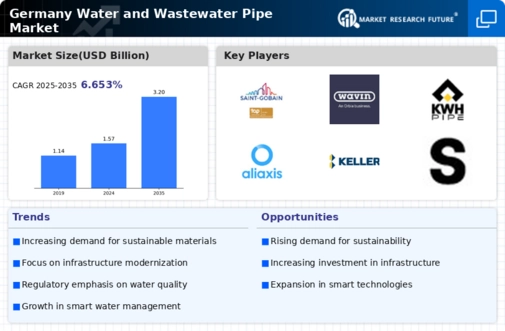Urbanization and Population Growth
Urbanization in Germany continues to drive demand in the water and-wastewater-pipe market. As cities expand and populations increase, the need for efficient water supply and wastewater management systems becomes more pressing. The urban population in Germany is expected to reach around 80% by 2025, necessitating the development of new infrastructure to support this growth. This trend indicates a potential increase in the installation of water and wastewater pipes, as municipalities seek to upgrade aging systems and accommodate new developments. The market is likely to see a surge in demand for durable and efficient piping solutions that can withstand the pressures of urban environments, thereby enhancing the overall resilience of water management systems.
Regulatory Compliance and Standards
The water and-wastewater-pipe market in Germany is significantly influenced by stringent regulatory compliance and standards. The German government has established comprehensive regulations to ensure the safety and quality of water supply and wastewater management. These regulations often necessitate the use of advanced materials and technologies in pipe manufacturing, which can lead to increased costs but also enhances the overall reliability of the infrastructure. As of 2025, the market is projected to grow at a CAGR of approximately 4.5%, driven by the need for compliance with these regulations. The emphasis on maintaining high standards in water quality and environmental protection is likely to propel investments in the water and-wastewater-pipe market, ensuring that manufacturers align with the latest guidelines.
Environmental Awareness and Sustainability
Environmental awareness among consumers and businesses in Germany is increasingly influencing the water and-wastewater-pipe market. There is a growing demand for sustainable practices in water management, prompting manufacturers to adopt eco-friendly materials and production processes. The market is witnessing a shift towards pipes that are recyclable and have a lower carbon footprint. As of 2025, it is estimated that around 25% of new projects will prioritize sustainability, reflecting a broader trend towards environmental responsibility. This shift not only aligns with governmental policies aimed at reducing environmental impact but also caters to the preferences of environmentally conscious consumers, thereby driving innovation in the market.
Aging Infrastructure and Rehabilitation Needs
Germany's aging infrastructure poses a significant challenge for the water and-wastewater-pipe market. Many existing pipelines are over 50 years old and require urgent rehabilitation or replacement to prevent leaks and contamination. The estimated cost of upgrading these systems is in the billions of euros, highlighting the urgent need for investment in modern piping solutions. As of 2025, it is anticipated that approximately 30% of the market will be driven by rehabilitation projects aimed at improving the efficiency and safety of water distribution and wastewater management. This trend suggests that companies specializing in innovative materials and technologies for pipe rehabilitation may find substantial opportunities in the market.
Technological Integration and Smart Solutions
The integration of technology in the water and-wastewater-pipe market is becoming increasingly prevalent in Germany. Smart water management systems, which utilize sensors and data analytics, are being adopted to enhance the efficiency of water distribution and wastewater treatment. These technologies allow for real-time monitoring and management of water systems, reducing waste and improving service delivery. As of 2025, it is projected that investments in smart technologies will account for a significant portion of the market, potentially reaching €1 billion. This trend indicates a shift towards more intelligent infrastructure solutions, which could lead to improved operational efficiency and reduced costs for municipalities and service providers.





















Leave a Comment